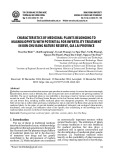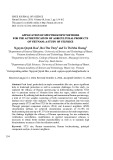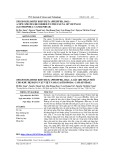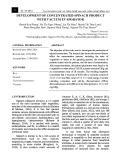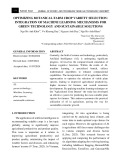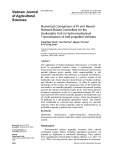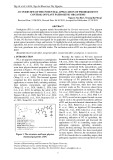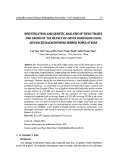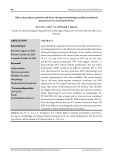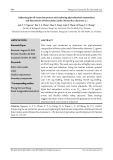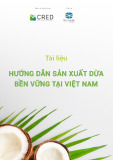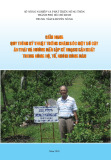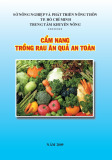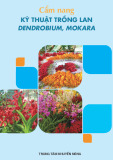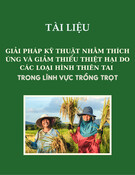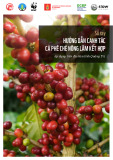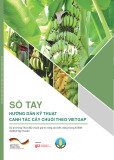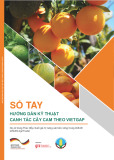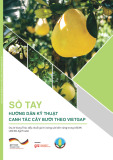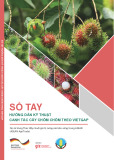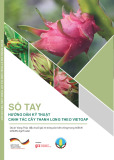
KHOA HỌC SỨC KHỎE
Volume 3, Issue 3 91
A MINI REVIEW ON THE PHYTOCHEMICAL COMPOSITION
AND BIOLOGICAL ACTIVITIES OF AGASTACHE RUGOSA
Nguyen Ngoc Linh1; Vu Ngoc Khanh2; Le Huyen Tram3
Tran Thu Huong4; Vu Quoc Manh5; Ha Manh Tuan6
1, 2, 5, 6Thanh Do University; 3, 4School of Chemistry and Life Sciences at Hanoi University of Science
and Technology.
Email: nnlinh@thanhdouni.edu.vn1; vungockhanh93@gmail.com2; tram.lehuyen@hust.edu.vn3;
huong.tranthu@hust.edu.vn4; vqmanh@thanhdouni.edu.vn5; hamanhtuan238@gmail.com6.
Received: 11/7/2024; Reviewed: 26/8/2024; Revised: 31/8/2024; Accepted: 25/9/2024
DOI: https://doi.org/10.58902/tcnckhpt.v3i3.159
Abstract: Agastache rugosa (Fisch. & C.A.Mey.) Kuntze, a medicinal and ornamental plant in the
Lamiaceae family, is mostly found in East Asian countries such as Vietnam, Korea, China, and Japan.
All parts of this plant are used as traditional medicines to treat abdominal pain, congestion, chills,
diarrhea, nausea, and vomiting, and dispel dampness. Phytochemical studies of this plant revealed that
it is a source of specialized metabolites including flavonoids, phenylpropanoids, lignans, and
terpenoids, which have useful pharmacological activities such as antioxidant, anti-inflammatory, anti-
allergic, anti-microbial, anti-depression, anti-cancer, anti-viral, anti-asthmatic, and cardiovascular
activities. Among them, acacetin (1), tilianin (2), and rosmarinic acid (19) are the main active
compounds of A. rugosa. However, most of the phytochemical and pharmacological studies belong to
A. rugosa species originating from Korea, China, and Japan. To date, there has only been one analysis
report on the constituents of the leaf and flower oils of A. rugosa in Vietnam. This review briefly
summarizes the chemical constituents and biological properties of A. rugosa that have been recently
reported.
Keywords: Lamiaceae; Biological actions; Phytoconstituents; Agastache rugosa; Review.
1. Introduction
Agastache is a small genus of the Lamiaceae
family, comprising 22 species of perennial
aromatic medicinal herbs (Zielińska &
Matkowski, 2014). Of them, A. rugosa (Fisch. &
C.A.Mey.) Kuntze is mostly found in East Asian
countries such as Vietnam, Korea, China, and
Japan (Li et al., 2013). A. rugosa has been used as
a wild vegetable and herbal drug for the treatment
of anorexia, vomiting, and other intestinal
disorders (Li et al., 2013). This herb is known
under many different names, such as Korean mint,
purple giant hyssop, Indiana mint, wrinkled giant
hyssop, "Tho Hoac Huong" (in Vietnam), “Huo
Xiang” (in China), and "Kakko" (in Japan)
(Itokawa et al., 1981; Loi, 1988). All parts of this
plant are used as traditional pharmaceuticals to
treat different disorders in various civilizations’
medical systems (Zielińska & Matkowski, 2014).
In Korea, this mint-fragranced plant has long been
used for the treatment of abdominal pain,
congestion, chills, and diarrhea. In addition, it is
also used as a wild vegetable, a spice a spice for
fish-based foods (Hong et al., 2020). In Chinese
traditional medicine, this plant has been used to
treat nausea, and vomiting, and dispel dampness
(Cao et al., 2017).
2. Research overview
Previous biological studies showed that
extracts of A. rugosa have antioxidant, anti-HIV,
antiatherogenic, antifungal, hypolipidemic,
carminative, and antipyretic properties (Gong et
al., 2012; Seo et al., 2019; Tuan et al., 2012).
Especially, the essential oil of A. rugosa possesses
various pharmacological properties such as
antibacterial, antifungal, antioxidant, anticancer,
antiviral, nematicidal, insecticidal, wrinkle
improver, stress reliever, and Alzheimer's disease
alleviator (Hong et al., 2020). Phytochemical
studies of this plant revealed that it is a source of
specialized metabolites including flavonoids,
phenylpropanoids, lignans, and terpenoids, which
have useful pharmacological activities such as

KHOA HỌC SỨC KHỎE
92 JOURNAL OF SCIENTIFIC RESEARCH AND DEVELOPMENT
antioxidant, anti-inflammatory, anti-allergic, anti-
microbial, anti-depression, anti-cancer, anti-viral,
anti-asthmatic, and cardiovascular activities (Lam
et al., 2020; Seo et al., 2019). However, most of
the above studies belong to A. rugosa species
originating from Korea, China, and Japan. There
is almost no phytochemical research on non-
volatile compounds and their biological activities
from A. rugosa originating in Vietnam. To date,
there has only been one analysis report on the
constituents of the leaf and flower oils of A.
rugosa from Vietnam (Dung et al., 1996). This
review briefly summarizes the chemical
constituents and pharmacological properties of A.
rugosa that have been recently reported.
3. Materials and methods
The available information on the chemical
constituents and biological properties of A. rugosa
was systematically collected via piles of resources
including classic books about Vietnamese herbal
medicine, and scientific databases including
Pubmed (https://pubmed.ncbi.nlm.nih.gov/),
Google Scholar (https://scholar.google.com/),
ACS, Web of Science, and Science Direct. Main
keywords used for the reference search included:
Agastache rugosa, Agastache genus, Lamiaceae,
“Thổ hoắc hương”, Agastache + phytochemistry,
Agastache + pharmacological property. The 2D
structures of compounds were constructed using
ChemBioDraw Ultra 21.0.0.28 (Cambridgesoft,
USA).
4. Results
4.1. Phytochemical constituents of A. rugosa
Figure 1. Chemical structure of 18 flavonoids 1-18 from A. rugosa
4.1.1. Flavonoids
Flavonoid is the main constituent of A. rugosa.
To date, 18 flavonoids have been isolated and
structurally characterized from A. rugosa
including acacetin (1) (An et al., 2018; Itokawa et
al., 1981; Park et al., 2016; Seo et al., 2019),
tilianin (2, acacetin-7-O-β-D-glucopyranoside)
(An et al., 2018; Itokawa et al., 1981; Park et al.,
2016; Seo et al., 2019), apigenin (3) (Park et al.,
2016; Seo et al., 2019), apigetrin (4) (Park et al.,
2016; Seo et al., 2019), diosmetin-7-O-β-D-
glucopyranoside (5) (Seo et al., 2019), luteoloside
(6) (Seo et al., 2019), diosmetin (7) (Seo et al.,
2019), luteolin (8) (Seo et al., 2019),
isoagastachoside (9) (Seo et al., 2019), acacetin-7-
O-(3″-O-acetyl)-β-D-glucopyranoside (10) (Park
et al., 2016; Seo et al., 2019), agastachoside (11)
(Itokawa et al., 1981), acacetin-7-O-(3″-O-
acetyl-6″-O-malonyl)-β-D-glucopyranoside (12)
(Seo et al., 2019), acacetin-7-O-(2″-O-acetyl-6″-
O-malonyl)-β-D-glucopyranoside (13) (An et al.,
2018; Seo et al., 2019), acacetin-7-O-(6″-O-
malonyl)-β-D-glucopyranoside (14) (Seo et al.,
2019), acacetin 7-O-β-(6''-O-(E)-

KHOA HỌC SỨC KHỎE
Volume 3, Issue 3 93
crotonylglucopyranoside) (15) (Park et al., 2016),
linarin (16, acacetin-7-O-rutinoside) (Itokawa et
al., 1981), agastachin (17) (Itokawa et al., 1981),
and (2S)-poncirenin (18) (Seo et al., 2019). Their
structures are shown in Figure 1. Among them,
tilianin (2) was a major constituent (1.96% of A.
rugosa methanol extract) (Hong et al., 2001).
4.1.2. Phenylpropanoids
Together with flavonoids, phenylpropanoids
are also the main constituent of A. rugosa.
Phenylpropanoid compounds that have been
isolated from A. rugosa include: rosmarinic acid
(19) (An et al., 2018; Seo et al., 2019), methyl
rosmarinate (20) (Seo et al., 2019), ethyl
rosmarinate (21) (Seo et al., 2019), methyl
caffeate (22) (Seo et al., 2019), ethyl caffeate (23)
(Seo et al., 2019), 1-hydroxy-2-O-β-D-
glucopyranosyl-4-allylbenzene (24) (Park et al.,
2016; Seo et al., 2019), 1-O-β-D-glucopyranosyl-
2-hydroxy-4-allylbenzene (25) (Park et al., 2016;
Seo et al., 2019), chavicol-β-D-glucopyranoside
(26) (Park et al., 2016; Seo et al., 2019), citrusin C
(27) (Park et al., 2016; Seo et al., 2019), 3-
hydroxyestragole-O-β-glucopyranoside (28)
(Park et al., 2016), (E)-4-hydroxycinnamyl
alcohol-4-β-glucopyranoside (16-29) (Park et al.,
2016), (3R,7R)-tuberonic acid-12-O-[6′-O-(E)-
feruloyl]-β-D-glucopyranoside (30) (Seo et al.,
2019), salicylic acid-2-O-[6′-O-(E)-feruloyl]-β-D-
glucopyranoside (31), phlorizin (32) (Seo et al.,
2019), chavicol-1-O-(6′-O-methylmalonyl)-β-D-
glucopyranoside (33) (Seo et al., 2019), chavicol-
1-O-(6′-O-acetyl)-β-D-glucopyranoside (34) (Seo
et al., 2019), nepetoidin B (35) (Seo et al., 2019),
estragole (36) (Li et al., 2013), eugenol (37) (Li et
al., 2013), and methyleugenol (38) (Li et al., 2013).
Their structures are shown in Figure 2. Among
these, the most typical compound is rosmarinic
acid (RA, 19). The highest amount of RA was
detected in flowers, where its content was 48.43
μg/g d.w., as well as in roots (30.97 μg/g) and
leaves (22.14 μg/g). The lowest content of RA was
reported in stems (9.14 μg/g) (Zielińska &
Matkowski, 2014). While, estragole (36, 8.55%),
eugenol (37, 7.54%), and methyleugenol (38,
50.51%) were determined as the principal
compounds of A. rugosa essential oil (Li et al.,
2013).
Figure 2. Chemical structures of phenylpropanoids 19-38 from A. rugosa
4.1.3. Terpenoids
Through GC-MS analysis (Li et al., 2013),
many monoterpenoids and sesquiterpenoids were
discovered in the A. rugosa essential oil. Typical
compounds with high concentrations can be
mentioned as follows: thymol, pulegone,
limonene, thymoquinone, and caryophyllene
(2.38%) (Li et al., 2013). There are four diterpenes
isolated from the root of Korea A. rugosa,
including agastanol (39) (Lee et al., 1994)
dehydroagastol (40) (Lee et al., 1994; Zou &
Cong, 1991), 19(4→3)-abeo-12,14,15-
trihydroxy-11-methoxy-abiet-4(18),8,11,13-

KHOA HỌC SỨC KHỎE
94 JOURNAL OF SCIENTIFIC RESEARCH AND DEVELOPMENT
tetraen-7-one (41) (Han et al., 1987b), and
agastaquinone (42) (Lee et al., 1995; Min et al.,
1999). In addition, six triterpenes: maslinic acid
(43) (Zou & Cong, 1991), oleanolic acid (44) (Zou
& Cong, 1991), 3-O-acetyloleanolic aldehyde (45)
(Han et al., 1987a; Zou & Cong, 1991), 3-O-
acetyloleanolic acid (46) (Han & Byon, 1988)
erythrodiol-3-O-acetate (47) (Han et al., 1987a),
and ursolic acid (48) (Cao et al., 2017) were also
isolated from A. rugosa. Their structures are
shown in Figure 3.
Figure 3. Chemical structure of terpenoids 39-48 from A. rugosa
4.1.4. Lignans, megastigmanes, steroids, and
other compounds
Up to now, there are only 2 lignans isolated and
structurally elucidated from A. rugosa including:
(8S,7′R,8′S)-4-hydroxybenzoic acid 4-(4-hydroxy-
3-methoxybenzyl)-2-(4-hydroxy-3-methoxyphenyl)
tetrahydrofuran-3-ylmethyl ester (agastinol, 49)
and (7′R,8′S)-4-hydroxybenzoic acid 4-(hydroxy-
3-methoxybenzylidene)-2-(4-hydroxy-3-
methoxyphenyl)-tetrahydrofuran-3-yl methyl
ester (agastenol, 50) (Lee et al., 2002). In addition,
other phytochemical investigations of the aerial
parts or leaves of A. rugosa revealed the presence
of megastigmanes [5β,6α-dihydroxy-3β-(β-
glucopyranosyloxy)-7-megastigmen-9-one (51),
(E)-4-[3′-(β-glucopyranosyloxy)butylidene] -
3,5,5-trimethyl-2-cyclohexen-1-one (52), and
(6R,9R)-3-oxo-α-ionol-9-O-β-glucopyranoside
(53) (Park et al., 2016; Seo et al., 2019), steroids
[β-sitosterol (54) (Cao et al., 2017) and
daucosterol (55)] (Zou & Cong, 1991), and other
compounds [benzyl β-glucopyranoside (56) (Park
et al., 2016), salidroside (57) (Park et al., 2016),
cimidahurinine (58) (Park et al., 2016), anisic acid
(59) (Seo et al., 2019), protocatechuic acid (60)
(Cao et al., 2017), and methyl hexadecanoate (61)
(Cao et al., 2017)] (Figure 4).
4.2. Biological properties of A. rugosa
The essential oil of A. rugosa possesses various
pharmacological properties such as antibacterial,
antifungal, antioxidant, anticancer, antiviral,
nematicidal, insecticidal, wrinkle improver, stress
reliever, and Alzheimer's disease alleviator (Hong
et al., 2020). The phytotoxic and antimicrobial
activities of the A. rugosa essential oils could
result from one of its main constituents, estragole
(36). Estragole isolated from A. rugosa was more
efficient against human pathogenic fungi as a pure
compound than as a crude essential oil (Zielińska
& Matkowski, 2014). Previous reports indicated
that acacetin (1), tilianin (2), and rosmarinic acid
(19) are the main active compounds of A. rugosa
(Lam et al., 2020; Tuan et al., 2012; Zielińska &
Matkowski, 2014). They are well-known for their
pharmacological activities such as antioxidant,
anti-inflammatory, anti-allergic, anti-microbial,
anti-depression, anti-cancer, anti-viral, anti-
asthmatic, and cardiovascular activities (Lam et
al., 2020; Seo et al., 2019; Tuan et al., 2012;
Zielińska & Matkowski, 2014). The high content
of these active compounds contributes to the
pharma- cologically useful properties of this species.
The concentrations of acacetin (1), tilianin (2), and
rosmarinic acid (19) in A. rugosa were the highest
in the flowers (Tuan et al., 2012). A. rugosa
diterpenes: agastanol (39) and dehydroagastol (40)
showed cytotoxic activities against human cancer
cell lines. While agastanol (39) and agastaquinone
(42) exhibited significant inhibitory effects against

KHOA HỌC SỨC KHỎE
Volume 3, Issue 3 95
human immunodeficiency virus type 1 (HIV-1)
protease activity with IC50 values of 360 and 87 μM,
respectively. Most recently, the remarkable anti-
inflammatory properties of A. rugosa flavonoids
(1, 2, 6, 7, 9, and 12) and phenyl propanoids (31,
33, and 34) have also been documented through
their inhibitory effects against the production of
prostaglandin E2 (PGE2) in LPS-induced RAW
264.7 macrophages (Seo et al., 2019).
Figure 4. Chemical structure of compounds 49-61 from A. rugosa
5. Discussions
Of the three most important medicinal species
in the genus Agastache, A. rugosa is the main
object in most of the published bioactivity data. A.
rugosa is the only species native to East Asia, and
it is an important herbal drug in Chinese, Korean
and Japanese traditional medicine. As such, it has
been frequently studied for various
pharmacological activities in both in vitro and
animal models. Pharmacological results have
validated the use of A. rugosa in traditional
medicine. As literature demonstrated, flavonoids
and rosmarinic acid derivatives are the main
constituents and responsible for most of the
biological activities shown by this plant. However,
the detailed active compounds and the underlying
mechanisms remain a work in progress. In
addition, more attention should be paid to the
phytochemical investigation of A. rugosa species
originating from Vietnam.
6. Conclusions
All the above-mentioned findings suggest the
importance of A. rugosa for East Asian traditional
medicine, which can be expected to extend to
other regions, similar to the already more popular
herbs from the Lamiaceae family. All parts of this
plant are used as traditional medicines to treat
abdominal pain, congestion, chills, diarrhea,
nausea, and vomiting, and dispel dampness. To
date, sixty-one compounds have been isolated
from A. rugosa via chromatography methods.
Their structures were classified into some main
groups of flavonoids, phenylpropanoids, lignans,
and terpenoids, which have useful
pharmacological activities such as antioxidant,
anti-inflammatory, anti-allergic, anti-microbial,
anti-depression, anti-cancer, anti-viral, anti-
asthmatic, and cardiovascular activities. Among
them, acacetin (1), tilianin (2), and rosmarinic acid
(19) are the main active compounds of A. rugosa.
However, most of the phytochemical and
pharmacological studies belong to A. rugosa
species originating from Korea, China, and Japan.
To date, there has only been one analysis report on
the constituents of the leaf and flower oils of A.
rugosa in Vietnam. Therefore, future studies on
the chemical composition and biological activity
of A. rugosa originating from Vietnam are very
necessary and need to be focused on.
References
An, J. H., Yuk, H. J., Kim, D.-Y., Nho, C. W., Lee,
D., Ryu, H. W., & Oh, S.-R. (2018). Evaluation
of phytochemicals in Agastache rugosa (Fisch.
& CA Mey.) Kuntze at different growth stages
by UPLC-QTof-MS. Industrial Crops
Products, 112, 608-616.

